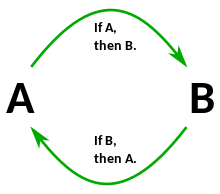
Back Sirkelredenasie Afrikaans استدلال دائري Arabic Кръгова логика Bulgarian Argumentació circular Catalan بەڵگەھێنانەوەی بازنەیی CKB Cirkulær argumentation Danish Zirkelschluss German Circulus in demonstrando DIQ Φαύλος κύκλος Greek Circular reasoning English
The English used in this article or section may not be easy for everybody to understand. (April 2023) |

Circular reasoning (Latin: circulus in probando, "circle in proving";[1] also known as circular logic) is a logical fallacy. With this fallacy, the reasoner begins with what they are trying to end with.[2] Circular reasoning is not a formal logical fallacy, but a pragmatic defect in an argument. In this fallacy, the premises need to be proved the same way as the conclusion. In a normal argument, the premises do not need to be proved. Since the premises also need to be proved, the argument does not persuade. There is no reason to accept the premises unless a person already believes the conclusion, or that the premises provide no independent ground or evidence for the conclusion.[3] Circular reasoning is closely related to begging the question, and in modern usage the two generally refer to the same thing.[4]
Circular reasoning is often of the form: "A is true because B is true; B is true because A is true." Circularity can be difficult to detect if it involves a longer chain of propositions.
- ↑ Chisholm, Hugh, ed. (1911). . Encyclopædia Britannica. Vol. 6 (11th ed.). Cambridge University Press. p. 389.
- ↑ Dowden, Bradley (27 March 2003). "Fallacies". Internet Encyclopedia of Philosophy. Archived from the original on 9 October 2014. Retrieved April 5, 2012.
- ↑ Nolt, John Eric; Rohatyn, Dennis; Varzi, Achille (1998). Schaum's outline of theory and problems of logic. McGraw-Hill Professional. p. 205. ISBN 9780070466494.
- ↑ Walton, Douglas (2008). Informal Logic: A Pragmatic Approach. Cambridge University Press. ISBN 9780521886178.
© MMXXIII Rich X Search. We shall prevail. All rights reserved. Rich X Search